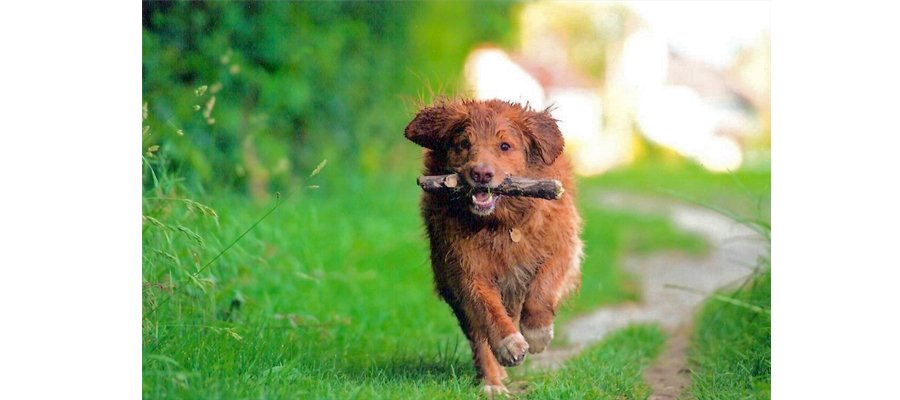This is Jock. He suffers with the dog health problem, osteoarthritis in his left hip.
Also known as degenerative joint disease (DJD), osteoarthritis is a painful and progressive disease (i.e. it continues to get worse over time), that involves the permanent, long-term deterioration and destruction of the cartilage and components surrounding the joints, which results in chronic pain, inflammation and decreased mobility.
The condition is characterised by the weakening and eventual loss of the smooth articular cartilage that covers and protects the ends of bones in a synovial joint. This results in joint friction, pain and inflammation caused by bone rubbing against bone. Additionally, new bone is also formed at the articular margins in an attempt by the body to fuse the affected joint thus reducing the friction and associated pain brought about by the degenerative process.
Osteoarthritis is diagnosed via an exam by your vet.
Thought to affect up to 1 in 5 dogs, osteoarthritis is the most common cause of lameness in dogs, with older dogs the most at risk. It mostly affects the hips, lower spine, stifle (knee) and hock (ankle), and the shoulder and elbow to a lesser degree.
Causes
PetMD (1999-2014e) states that ‘there is no known cause for primary DJD… however, the are a wide variety of causes for secondary DJD’. For example, the dog may have been born with a developmental issue, such as elbow or hip dysplasia or osteochondrosis, which leaves them more prone to developing secondary DJD.
The dog may suffer from a dislocating kneecap or shoulder, or perhaps had an injury, trauma or some other issue with joint stability (i.e. ruptured cruciate ligament, joint fracture) which has lead to the development of DJD in the joint.
The condition may be quite prevalent in older dogs via normal wear and tear with age. Furthermore, heavy, large-breed or obese dogs can be more susceptible to DJD due to the additional stresses placed on joints and ligaments.
Symptoms
If your dog is suffering from osteoarthritis, they may exhibit the following symptoms:
- Decreased levels of activity – lagging behind on walks
- Reluctance to walk, run, jump, play or climb/descend stairs – see ‘Jock and stairs’ video below
- Varying degrees of lameness, stiffness and joint pain – more apparent in the morning and getting up from a nap
- Altered and stiffness in gait that worsens with exercise
- Muscle atrophy in affected limb
- Difficulty rising or sitting
- Soreness when touched
- Change in appetite
- Restlessness or insomnia
- Pain vocalisation
- Aggressive or withdrawn behaviour
- Licking or biting the painful area
- Seeking out warm or soft places to rest/sleep
Treatment and Early Prevention
Although canine osteoarthritis is incurable, a lot can be done to treat the underlying cause, slow the disease progression, control the associated pain, and improve the quality of the dog’s life.
- Surgery – can alleviate symptoms and slow the progression of the disease. Includes femoral head and neck excision, total hip/elbow replacement, removal of aggravating causes, such as bone or cartilage fragments in a joint, treatment to correct the causes of hip dysplasia and cruciate rupture
- Long-term medication (i.e. anti-inflammatory drugs) – to help reduce joint pain and swelling
- Physical therapy – to maintain or increase joint motion (i.e. motion exercises, swimming, massage) and to strengthen muscle tone
- Cold and heat therapy to manage arthritic pain
- Exercise moderation and weight control – as a treatment
- Acupuncture
- Healthy diet and exercise – to prevent obesity
- Avoidance of trauma – early prevention (although this may be impossible!)
Massage Treatment for Osteoarthritis
Massage can be used to effectively relieve pain from secondary muscle problems, in other words, those muscles affected via compensation i.e., in the weight-bearing limb. In the video above, you can see that Jock is initially apprehensive about going up the stairs. He then starts his upward journey, but always leads with his right leg – this is the leg that is therefore bearing the most weight. (The muscles in his right leg are much more developed that those in his left.) Also, Jock will be using his neck and front legs to help him to move about, therefore increasing the tension in these areas.
We see Jock once a month for massage treatment. He has additional help via acupuncture and takes regular dips in the hydrotherapy pool to help strengthen the muscles in his affected leg. His owner is certain that this is helping to keep him youthful and in great shape! Go Jock!
Sources:
- Colville, T., Bassert, J.M., 2008. Clinical Anatomy and Physiology for Veterinary Technicians. 2nd ed. St. Louis: Mosby Elsevier.
- Foster and Smith, 1997-2013c. Arthritis (Degenerative Joint Disease, Osteoarthritis). Available at: http://www.peteducation.com/article.cfm?c=2+2084&aid=271
- Houredebaigt, J-P., 2004. Canine Massage – A Complete Reference Manual. 2nd ed. Wenatchee: Dogwise Publishing.
- petMD, 1999-2014e. Degenerative Joint Disease in Dogs. Available at: http://www.petmd.com/dog/conditions/musculoskeletal/c_multi_arthritis_osteoarthritis
- Robertson, J., 2010. The Complete Dog Massage Manual. Dorset: Veloce Publishing Ltd.
- Robertson, J., Mead, A., 2013. Physical Therapy and Massage for the Dog. London: Manson Publishing Ltd.
- WebMD, 2005-2014d. Arthritis in Dogs: Symptoms and Causes. Available at: http://pets.webmd.com/dogs/guide/arthritis-in-dogs-symptoms-and-causes.
- Zoetis, 2013-2014. Osteoarthritis. Available at: https://www.zoetis.co.uk/conditions/dogs/canine-osteoarthritis.aspx.
